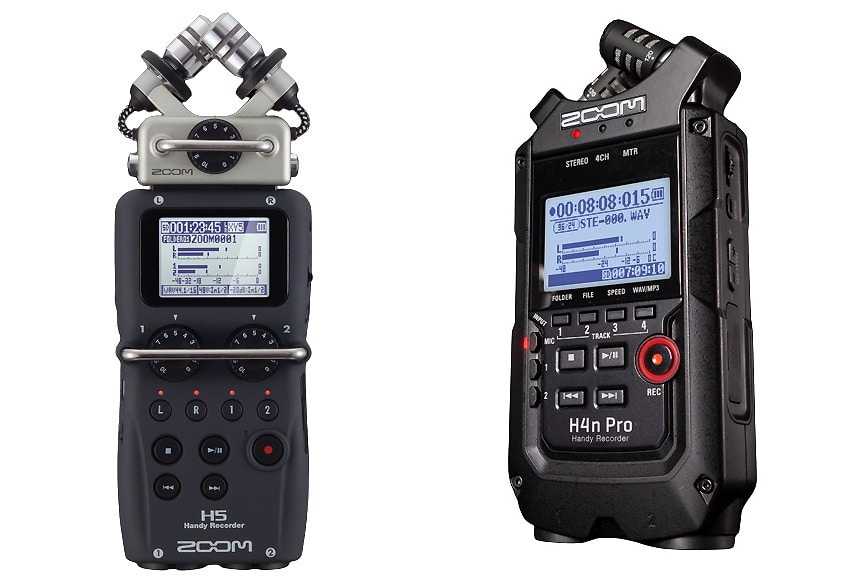Zoom H5 vs H4n Pro: Unmasking the Best Handheld Recording Device
Introduction of Zoom H5 vs H4n Pro

In this in-depth review, we'll compare two popular handheld recorders—the Zoom H5 and the Zoom H4n Pro. We'll delve Zoom H5 vs H4n Pro into various aspects, including inputs, battery life, size and build, display, versatility, capsules, -12dB backup feature, setting levels, sample rate and bit depth, audio interface capabilities, sound quality, wind protection, portability, guitar effects, affordability, ease of use, storage, and finally, provide a conclusion to help you make an informed decision.
Inputs:
Both the Zoom H5 and H4n Pro offer 2 x XLR inputs and a 3.5mm mini-jack input. The H5's 3.5mm input is in the X/Y capsule, but note that some other capsules lack a 3.5mm input. Both models support plug-in power for lav mics, but be cautious with TRRS plugs, and a TRRS to TRS cable adaptor might be needed.
Battery Life:
Zoom H5 boasts a longer battery life of up to 15 hours compared to H4n Pro's 6 hours. The H4n Pro is known for quick battery consumption, so packing spares is advisable. The H5 also offers an accessory pack for continuous power, the Zoom APH-5.
Size & Build:
While both recorders have good build quality, the H5 is preferred due to personal preference. Be aware of potential stickiness with rubberized coatings on some Zoom recorders over time.
Display:
Both the H4n Pro and H5 feature backlit displays suitable for low-light conditions. Although an articulated screen like those on cameras is desired, it's unlikely in audio recording devices.
Versatility:
The H5 excels in versatility due to its interchangeable capsules, allowing for a wide range of applications. Capsules like EXH-6 provide additional XLR inputs, XYH-6 for general recording, MSH-6 for mid-side recording, and SSH-6 for shotgun microphone use, expanding the recorder's capabilities.
-12dB Backup:
H5 features a -12dB backup function during recording, creating a quieter backup track. However, note that it seems limited to the Left and Right channels when using the X/Y capsule.
Setting Levels:
Properly setting gain levels is crucial to avoid clipping or recording at low levels. Adjust gain to peak just below 0dB for loud sounds, providing headroom for different sources.
Sample Rate, Bit Depth, and File Type:
Opt for 24-bit sample rate for recordings, using the .WAV format for rich audio information. Choose sample rates based on the intended use—44.1kHz for music, 48kHz for video, and 96kHz for specialized applications.
Audio Interface:
Both H5 and H4n Pro can function as audio interfaces by selecting USB and Audio Interface in the menu.
Sound Quality:
Both recorders use the same preamps and offer good sound quality for various applications. However, they may not excel in recording super quiet ambiences due to inherent hiss.
Wind Protection:
For outdoor recording, investing in a quality windshield, like Rycote's kit, is recommended to minimize wind noise.
Portability:
Both recorders are highly portable, but the H4n Pro is slightly smaller, making it a winner in terms of portability.
Guitar Effects:
Surprisingly, the H4n Pro offers guitar effects and built-in tuners, catering to guitarists.
Affordability:
Generally, the H4n Pro is slightly cheaper than the H5, but price isn't the sole factor in decision-making.
Ease of Use:
Both recorders have intuitive menus, but the H5 is considered easier to use due to manual gain knobs and additional features like a metal bar over the knobs for protection.
Storage:
Both devices use SD cards up to 32GB, but note that larger-capacity SD cards may slow down the H4n Pro's startup time.
Conclusion:
In conclusion, choose the Zoom H4n Pro for compactness, on-the-go recording without additional capsules, and up to 2 external mics. Opt for the H5 for enhanced versatility, interchangeable capsules, and the potential for future expansion.
To view more products ZOOM

Comments
Post a Comment